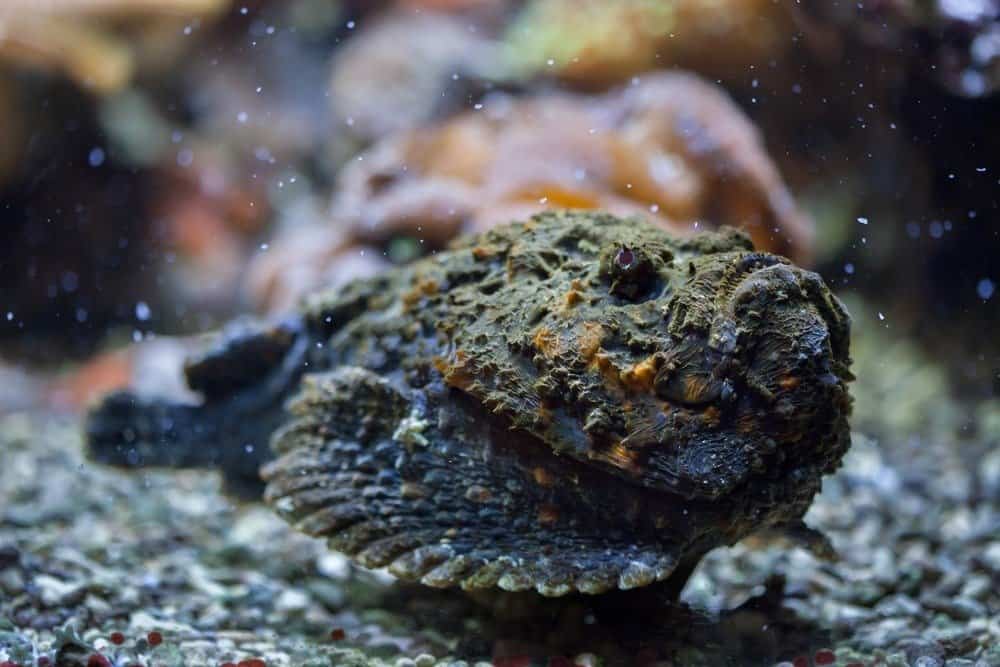Stonefish
The most venomous fish in the world
Advertisement
Stonefish Facts
- Prey
- Small fish and crustaceans
- Main Prey
- Shrimp
- Name Of Young
- Larva
- Group Behavior
- Solitary
- Fun Fact
- The most venomous fish in the world
- Estimated Population Size
- Millions
- Biggest Threat
- Habitat loss
- Most Distinctive Feature
- Powerful venom
- Distinctive Feature
- Warty skin
- Other Name(s)
- scorpionfish
- Age Of Independence
- Hatching
- Habitat
- Coral reefs
- Predators
- Sharks, sea snakes, eels, and stingrays
- Diet
- Carnivore
- Lifestyle
- Nocturnal
- Favorite Food
- Shrimp
- Common Name
- Stonefish
- Special Features
- Venomous spikes
- Number Of Species
- 5
- Location
- Indo-Pacific
View all of the Stonefish images!
Summary
One of the most venomous fish in the world, the stonefish, is a ray-finned fish in the family Scorpaenidae. They are a bottom-dwelling fish found throughout the Indo-Pacific. Instead of scales, it features warts and growths of algae all over its body. It uses camouflage to avoid predators and often appears like a rock resting on the ocean floor. Unlike most fish, it can survive out of water for up to 24 hours and live between 5 and 10 years in the wild.
5 Stonefish Squid Facts
- Stonefishes lack scales, and their skin is often covered with a layer of warty growths and algae.
- Instead of advertising their venomous nature with bright colors, they hide from predators using camouflage.
- Stonefishes utilize ambush tactics while hunting and can consume their prey within milliseconds.
- Just 18mg of their venom can prove fatal and causes numerous symptoms, including pain, paralysis, shock, and tissue necrosis.
- They are quite promiscuous, as females rarely discriminate when it comes to determining which males they allow to fertilize their eggs.
Stonefish Classification and Scientific Name
The stonefish belongs to the scorpionfish family Scorpaenidae. In total, there are 5 species that go by the name, all of which belong to the genus Synanceia. Synanceia verrucosa, also known as the reef stonefish, or simply stonefish, is the most common species within the genus. That said, scientists recognize the estuarine stonefish (Synanceia horrida) as the type species of the genus. The other species in the genus include the midget stonefish (Synanceia alula), the Red Sea stonefish (Synanceia nana), and Synanceia platyrhyncha. The genus name, Synanceia, derives from the Greek words syn, meaning “with,” and angeion, meaning “cavity,” which alludes to the large, cavernous head common among all stonefish. Meanwhile, the species name, verrucosa, translates to “covered with warts,” in reference to the warty growths that grow on their body.
Stonefish Appearance

Unlike some venomous species, which try to scare off predators with flashy colors, stonefishes rely on camouflage.
©Vladimir Wrangel/Shutterstock.com
Most stonefish appear rather drab, which helps them to blend in with rocks on the bottom of the ocean floor. They typically look either brownish-gray or reddish-brown, although some parts look yellow, orange, or green. Unlike most fish, they lack scales, and their bodies are covered in warts and growths of algae.
They possess small, upward-set eyes, behind each of which rests a deep pit. The head is wide and flat, while the mouth is large and practically vertical. They can grow up to 24 inches long, although most typically measure between 14 and 20 inches. Meanwhile, they have a maximum weight of 5 pounds.
Aside from its skin, the stonefish’s most distinguishing feature is its long dorsal spines. The dorsal fin contains between 12 and 14 spines and 5 to 7 soft rays. These spines all measure the same length and have venom glands located at their base.
Stonefish Behavior
Unlike some venomous species, which try to scare off predators with flashy colors, stonefishes rely on camouflage. Their drab colors and warty appearance makes them look like rocks when they rest on the bottom of the ocean floor. They are bottom-dwellers that do not actively search for their prey, opting instead to lie in wait for their food to come to them. In addition, they do not seek out the company of other stonefishes except to mate, living most of their lives in solitude. Their calm, quiet demeanor – along with their dangerous reputation – makes them popular aquarium attractions.
Stonefish Distribution, Population, and Habitat
You can find them throughout the Indian Ocean and the western Pacific Ocean. Their range extends from India to Papua New Guinea and from southern Japan to Australia. Some species, such as the Red Sea stonefish, live in and around the Red Sea and along the coasts of East Africa. In recent years, stonefishes have been spotted in the Mediterranean and were likely introduced after people released them from aquariums.
Stonefishes are benthic fish that spend most of their lives on the ocean floor. They prefer shallow, tropical waters to deeper, more temperate waters. You can often find them living in or around coral reefs, which provide plenty of cover from predators and access to food. They typically rest either on rocks or plants or directly on the seabed.
Stonefish Predators and Prey
Despite their potent venom, several animals still manage to prey on this fish. Their main predators include sharks, stingrays, eels, and sea snakes. These animals can eat stonefish while avoiding their venomous spines. Young ones are especially susceptible to predation.
All stonefish are nocturnal predators that prey on other marine animals. Their diet primarily consists of shrimp, other crustaceans, and small fish. Rather than actively hunting for food, they rely on ambush tactics to catch their prey. They sit motionlessly, wait for animals to swim by, and then swallow their prey. Despite their seemingly calm nature, they can strike at incredible speeds. According to records, some specimens can strike within 0.015 seconds.
Stonefish Reproduction and Life Cycle
Outside of the mating season, stonefish are primarily solitary. Even during the mating season, they come together for only a short time before going their separate ways. Sexually mature females lay their unfertilized eggs in the soft substrate in and around coral reefs. Males then swim by and release their sperm to fertilize the eggs. Stonefishes display a high level of promiscuity, as females tend not to discriminate between which males they allow to fertilize their eggs.
Their eggs measure quite large, and the larvae are already quite well-developed upon hatching. Although few live to adulthood, those that do enjoy a life expectancy between 5 and 10 years.
Stonefish Poison
The stonefish ranks as one of if not the most venomous fish in the world. Each of its dorsal spines contains two venom sacs which produce a potent toxin. Even in small quantities, stonefish venom can wreak havoc on the cardiovascular and neuromuscular systems. Just 18 milligrams can prove fatal and represents just half of the venom a single stonefish can release. Symptoms of their stings include intense pain, paralysis, shock, and tissue death. Common medical treatments include anti-venom and anesthetics for the pain. With treatment, symptoms still tend to persist for 24 to 48 hours, and some victims suffer long-term nerve damage or muscle atrophy.
Stonefish in Fishing and Cooking
The main threat to stonefishes comes from human activity. They make their homes in coral reefs, many of which are under threat due to climate change and environmental pollution. In addition, stonefishes are often captured for use in the pet trade as aquarium attractions. However, some cultures consume them as food, particularly in the Philippines, China, and Japan. People often cook stonefish with ginger in soups and sometimes eat them raw as part of sushi or sashimi.
Stonefish Population
Although few stonefish live to adulthood, they are still relatively common fish. Their use in commercial fishing is also limited, which has helped keep stonefish populations stable. While the continued destruction of coral reefs may affect their populations in the future, no species shows significant signs of decline at this time. As a result, the IUCN lists them as a species of Least Concern.
Related Animals:
View all 293 animals that start with SStonefish FAQs (Frequently Asked Questions)
Are stonefishes carnivores, herbivores, or omnivores?
Stonefishes are carnivorous predators that eat small fishes and crustaceans. They hunt using ambush tactics and wait for their prey to swim close before lashing out quickly.
Can you survive a stonefish sting?
The stonefish is one of the most venomous fish in the world that can prove potentially fatal to humans. Stonefish stings are especially dangerous to children, elderly people, and those with weakened immune systems.
Can you eat stonefish?
You can eat a stonefish so long as it is prepared correctly. The venom in its flesh breaks down when cooked, and you can even eat it raw so long as you remove the dorsal fin first.
Can stonefish pierce water shoes?
Stonefish spines are incredibly sharp and strong and can easily pierce through the boot of a wetsuit or water shoe.
Where are stonefish found?
You can find stonefishes throughout the Indo-Pacific, particularly in and around coral reefs.
Thank you for reading! Have some feedback for us? Contact the AZ Animals editorial team.
Sources
- , Available here: https://www.zoobasel.ch/en/tiere/tierlexikon/tierbeschreibung/378/steinfisch/
- , Available here: https://oceana.org/marine-life/stonefish/
- , Available here: https://www.cebuoceanpark.com/animals_post/stone-fish/
- , Available here: https://www.sciencedirect.com/science/article/abs/pii/S0041010120302518
- , Available here: https://www.cnn.com/2018/04/12/health/stonefish-switchblade-lachrymal-saber-trnd/index.html

















